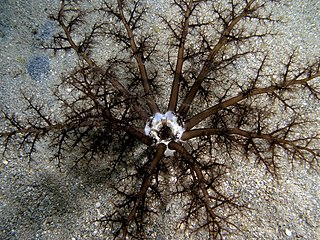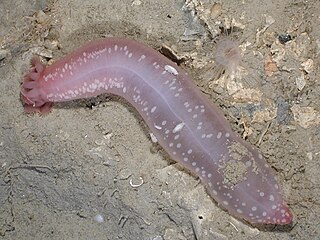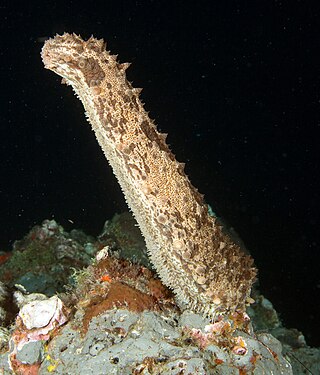
An echinoderm is any deuterostomal animal of the phylum Echinodermata, which includes starfish, brittle stars, sea urchins, sand dollars and sea cucumbers, as well as the sessile sea lilies or "stone lilies". While bilaterally symmetrical as larvae, as adults echinoderms are recognisable by their usually five-pointed radial symmetry, and are found on the sea bed at every ocean depth from the intertidal zone to the abyssal zone. The phylum contains about 7,600 living species, making it the second-largest group of deuterostomes after the chordates, as well as the largest marine-only phylum. The first definitive echinoderms appeared near the start of the Cambrian.

Sea cucumbers are echinoderms from the class Holothuroidea. They are marine animals with a leathery skin and an elongated body containing a single, branched gonad. They are found on the sea floor worldwide. The number of known holothurian species worldwide is about 1,786, with the greatest number being in the Asia-Pacific region. Many of these are gathered for human consumption and some species are cultivated in aquaculture systems. The harvested product is variously referred to as trepang, namako, bêche-de-mer, or balate. Sea cucumbers serve a useful role in the marine ecosystem as they help recycle nutrients, breaking down detritus and other organic matter, after which bacteria can continue the decomposition process.

The California sea cucumber, also known as the giant California sea cucumber, is a sea cucumber that can be found from the Gulf of Alaska to Baja California. It is found from the low intertidal zone to a depth of 250 m (820 ft). They are most abundant in areas with moderate current with cobbles, boulders or bedrock. They are artisanally fished.

Sea apple is the common name for the colorful and somewhat round sea cucumbers of the genus Pseudocolochirus, found in Indo-Pacific waters. Sea apples are filter feeders with tentacles, ovate bodies, and tube-like feet. As with many other holothurians, they can release their internal organs or a toxin into the water when stressed.

Dendrochirotida are an order of sea cucumbers. Members of this order have branched tentacles and are suspension feeders. Examples include Thyonella and Cucumaria.
Evisceration is a method of autotomy involving the ejection of internal organs used by animals as a defensive strategy. Sea cucumbers (Holothuroidea) eject parts of the gut in order to scare and defend against potential predators such as crabs and fish. The organs are regenerated in a few days by cells in the interior of the sea cucumber.

The orange-footed sea cucumber is the largest sea cucumber in New England, United States. It is one of the most abundant and widespread species of holothurians within the North Atlantic Ocean and the Barents Sea (Russia), being most abundant along the eastern coast of North America.

Cucumaria miniata is a species of sea cucumber. It is commonly known as the orange sea cucumber or red sea cucumber due to its striking color. This northeast Pacific species is often found wedged in between rocks or crevices at the coast or on docks and can generally be identified by its orange bushy tentacles protruding above the substrate.

Holothuria forskali, the black sea cucumber or cotton-spinner is a species of sea cucumber in the family Holothuriidae. It is found at shallow depths in the eastern Atlantic Ocean and the Mediterranean Sea. It was placed in the subgenus Panningothuria by Rowe in 1969 and is the type taxon of the subgenus.

Phyllophoridae is a family of sea cucumbers, marine invertebrates with elongated bodies, leathery skins and feeding tentacles.

Sclerodactyla briareus, commonly known as the hairy sea cucumber, is a species of marine invertebrate in the family Sclerodactylidae. It is found in shallow waters in the western Atlantic Ocean.

Holothuria leucospilota, commonly known as the black sea cucumber or black tarzan, is a species of marine invertebrate in the family Holothuriidae. It is placed in the subgenus Mertensiothuria making its full scientific name Holothuria (Mertensiothuria) leucospilota. It is the type species of the subgenus and is found on the seabed in shallow water in the Indo-Pacific.

Chiridotidae is a family of sea cucumbers found in the order Apodida. Within the family, there are 16 recognized genera all with different ranges of body types and functions. Sea cucumbers play a fundamental role in many marine ecosystems.
Thyonicola americana is a species of parasitic sea snail, a marine gastropod mollusc in the family Eulimidae. It infests the sea cucumbers Eupentacta quinquesemita and Eupentacta pseudoquinquesemita in Puget Sound and other parts of the northeastern Pacific Ocean.

Synaptula recta, sometimes known as the gut-like sea cucumber, is a species of sea cucumber in the family Synaptidae in the phylum Echinodermata. It occurs in shallow water in the tropical Indo-Pacific region.

Pawsonia saxicola, the sea gherkin, is a species of sea cucumber in the family Cucumariidae. It is found in the northeastern Atlantic Ocean and the Mediterranean Sea.

Thyone fusus is a species of sea cucumber in the family Phyllophoridae. It is found on the seabed in the northeastern Atlantic Ocean and the Mediterranean Sea. It is a suspension feeder and catches food particles floating past with its branching feeding tentacles.
Holothuria grisea, the gray sea cucumber, is a mid-sized coastal species of sea cucumber found in shallow tropical waters of the Atlantic Ocean from Florida to Southern Brazil and West Africa. They have a variety in color and can range from red to more yellowish with brown markings. They are also a food source for local and international markets with the majority of harvesting taking place in Brazil. This species is currently not over-fished and is not endangered or threatened.

Actinopyga agassizii, commonly known as five-toothed sea cucumber or West Indian sea cucumber, is a species of sea cucumber in the family Holothuriidae. It was first described by German zoologist Emil Selenka in 1867. It is native to the Western Atlantic region, including the Gulf of Mexico and the Caribbean Sea, and is harvested for food.

Actinopyga varians, the Pacific white-spotted sea cucumber or Hawaiian sea cucumber, is a species of sea cucumber in the family Holothuriidae. It is found in the Pacific Ocean near Hawaii and also in the Indo-Pacific Ocean.
















